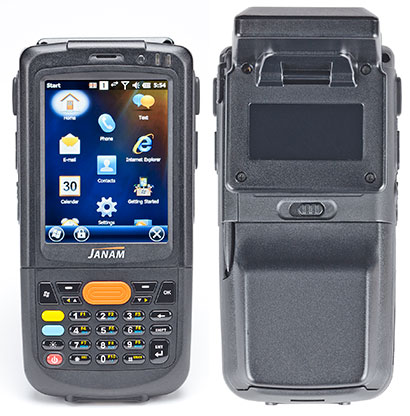Janam is a New York-based rugged mobile computing vendor with worldwide distribution. The company was established in 2006 as a provider of purpose-built rugged handheld computing devices for mobile workers. In July 2015, the company introduced the Janam XM2-RFID UHF, a rugged mobile computer designed to deliver business-critical enterprise features to organizations in multiple industries, including retail, transportation and logistics, manufacturing and defense.

Those familiar with Janam's lineup of rugged handheld computers may wonder how this new model is different from the XM2-RFID for Rail that the company introduced in April 2015. The looks and specs seem identical, and checking back with Janam confirmed that the two models are indeed basically identical, except for their RFID tag read design. Whereas the XM2-RFID for Rail is specifically designed for working with the AEI (Automatic Equipment Identification) electronic recognition system used by the North American railroad industry, the new XM2-RFID UHF extends the product line to other industries with the ability to read ISO18000-63, EPC Global Class 1 Gen 2 tags.
What's EPCglobal Class 1 Gen 2, ISO18000-63?
EPC stands for Electronic Product Code. It's essentially a replacement for the older UPC (Universal Product Code) and was designed to be a comprehensive, flexible, universal and unique identifier for physical objects. Whereas the older UPC uses a visible bar code, a set of numbers, and requires a barcode reader, EPC uses radio signals and RFID readers. And EPCglobal is the organization created to handle the standardization and worldide adoption of EPC technology.
As for the "Class 1," there are different classes of RFID tags. Class 0 and 1 are read-only passive tages, Class 2 are passive but have additional capabilities, Class 3 are "semi-passive," Class 4 are active tags that can communicate with one another, and Class 5 can power Classes 1-3 and communicate with 4 and 5. "Gen 2" represents the second, enhanced generation of the standard, with Gen 2 having been adopted in 2004 (also see RFID Gen 2 - what is it?).
How does EPCglobal classification relate to ISO 18000? In short, the EPC system handles naming, coding, the way the tag works, and the way the radio interface works. The ISO 18000 standard, on the other hand, only deals with the air interface, i.e. how tags and readers communicate. ISO 18000-6, specifically, covers the 860 MHz to 960 MHz band and was designed to work globally. UHF, finally, stands for Ultra High Frequency, with the Gen 2 standard using the 860 MHz to 960 MHz band. It's faster, allows a longer range, and tages are cheaper than LF (Low Frequencey) and HF (High Frequency) RFID. RFID Journal has a nice FAQ on all of this (see RFID Journal FAQ and also see Impinj's The Different Types of RFID Systems).
The device itself
As far as the device itself goes, Janam again adheres to its time-tested approach of making available popular legacy technology that, while mature, has been polished and updated for the job. Remember that Janam was selling Palm OS-based handhelds long after Palm itself had vanished, and to this day customers can get Palm OS devices from Janam (see Janam's XP series).
So the XM2-RFID UHF is a traditional ruggedized Pocket PC design with integrated keypad, a small 3.2-inch QVGA (240 x 320 pixel) screen, a modest 128MB or 256MB of RAM and Flash each (plus whatever is in the unit's user-accessible micro SDHC slot). The whole thing is powered by a non-specified Freescale ARM 9 processor, and runs Windows Embedded Handheld 6.5. That's enough technology for the job at hand. More would be wasted and simply add to costs.
Measuring 2.9 x 5.8 inches, the XM2-RFID UHF has a foorptint just a bit smaller than that of an iPhone 6 Plus. It's about an inch thick, which means it can accommodate an industrial-grade Motorola SE4500 1D/2D scanner and a suitably-sized battery. Weight is 13 ounces, quite manageable.
Devices designed for heavy-duty RFID reading can always be recognized by the large external RFID module, and this Janam handheld is no different. In terms of performance, Janam claims the device can read AEI tags from at least a meter (3.3 feet) away. In their tests, after reading 40,000 tags in a continuous five hour stretch, the battery still had 20% charge left. That means it should last at least a full shift in normal everyday use.
As one would expect, the Janam XM2-RFID UHF is a tough and durable device. It will survive multiple 4-foot drops onto concrete, can be operated in a wide -4 to 122 degree temperature range, and is sealed to IP64 level, which means this handheld is totally dustproof and can also handle water sprayed on it from all directions.
Overall, the Janam XM2-RFID UHF is a very cleverly conceived product that cost-efficiently provides just the right performance and features needed for the rapidly growing use of RFID data capture technology in numerous fields, and it does so in a rational, field-proven design and with rational, field-proven technology.
Janam Technologies LLC · janam.com · 1-516-677-9500






